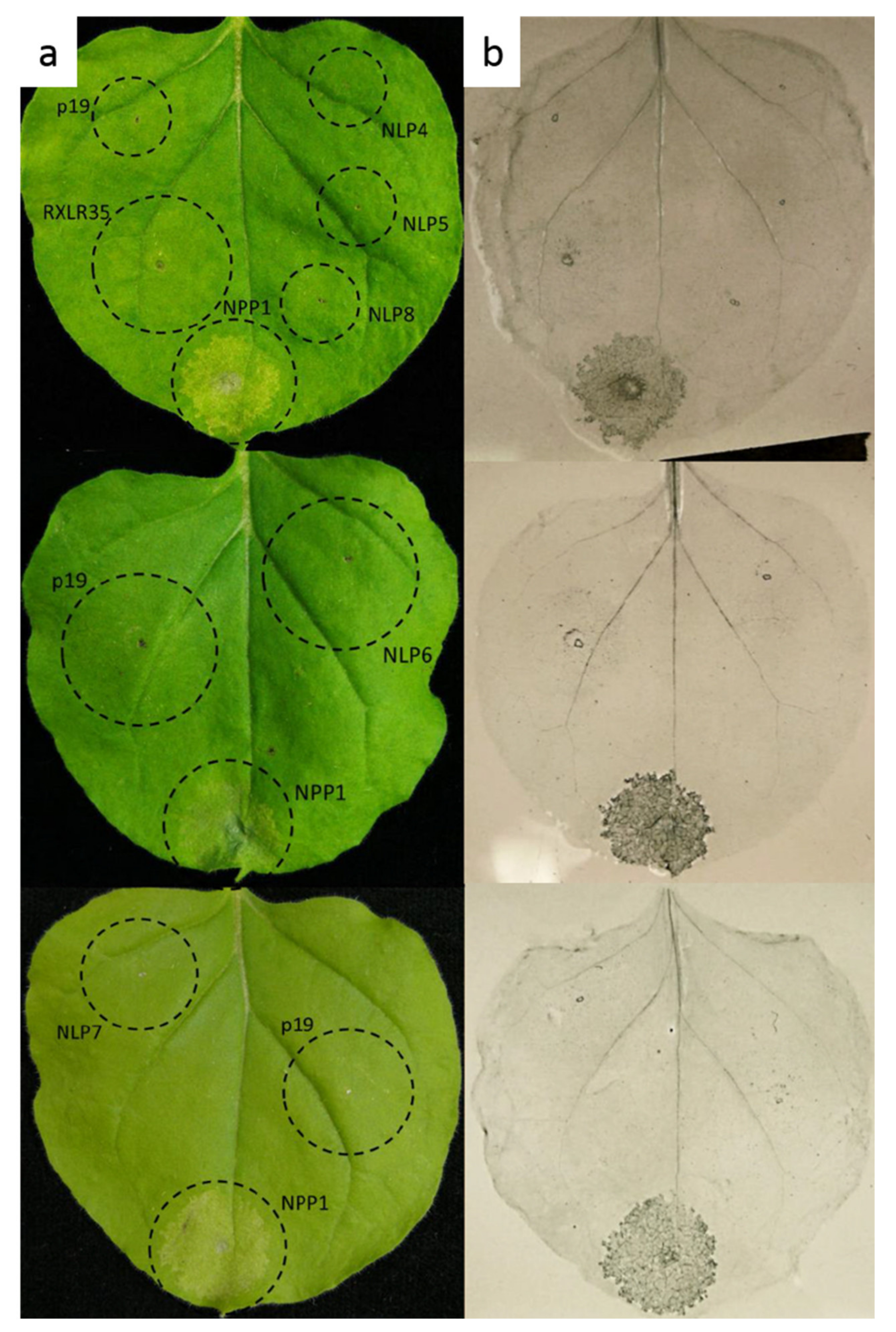Sequence and Gene Expression Analysis of Recently Identified NLP from Plasmopara viticola
Abstract
:1. Introduction
2. Materials and Methods
3. Results & Discussion
3.1. Sequence Analysis of PvNLP4–PvNLP8
3.2. Gene Expression Analysis
3.3. Necrosis-Inducing Activity
Author Contributions
Funding
Data Availability Statement
Acknowledgments
Conflicts of Interest
References
- Seidl, M.F.; Van Den Ackerveken, G. Activity and Phylogenetics of the Broadly Occurring Family of Microbial Nep1-like Proteins. Annu. Rev. Phytopathol. 2019, 57, 367–386. [Google Scholar] [CrossRef] [PubMed]
- Gijzen, M.; Nürnberger, T. Nep1-like Proteins from Plant Pathogens: Recruitment and Diversification of the NPP1 Domain across Taxa. Phytochemistry 2006, 67, 1800–1807. [Google Scholar] [CrossRef]
- Oome, S.; Van den Ackerveken, G. Comparative and Functional Analysis of the Widely Occurring Family of Nep1-Like Proteins. Mol. Plant-Microbe Interact. 2014, 27, 1081–1094. [Google Scholar] [CrossRef] [Green Version]
- Fellbrich, G.; Romanski, A. NPP1, a Phytophthora-Associated Trigger of Plant Defense in Parsley and Arabidopsis. Plant J. 2002, 32, 375–390. [Google Scholar] [CrossRef] [PubMed]
- Ottmann, C.; Luberacki, B. A Common Toxin Fold Mediates Microbial Attack and Plant Defense. Proc. Natl. Acad. Sci. USA 2009, 106, 10359–10364. [Google Scholar] [CrossRef] [PubMed] [Green Version]
- Böhm, H.; Albert, I. A Conserved Peptide Pattern from a Widespread Microbial Virulence Factor Triggers Pattern-Induced Immunity in Arabidopsis. PLoS Pathog. 2014, 10, e1004491. [Google Scholar] [CrossRef]
- Oome, S.; Raaymakers, T.M. Nep1-like Proteins from Three Kingdoms of Life Act as a Microbe-Associated Molecular Pattern in Arabidopsis. Proc. Natl. Acad. Sci. USA 2014, 111, 16955–16960. [Google Scholar] [CrossRef] [Green Version]
- Albert, I.; Böhm, H. An RLP23-SOBIR1-BAK1 Complex Mediates NLP-Triggered Immunity. Nat. Plants 2015, 1, 1–9. [Google Scholar] [CrossRef]
- Mattinen, L.; Tshuikina, M. Identification and Characterization of Nip, Necrosis-Inducing Virulence Protein of Erwinia Carotovora Subsp. Carotovora. Mol. Plant-Microbe Interact. 2004, 17, 1366–1375. [Google Scholar] [CrossRef] [Green Version]
- Santhanam, P.; Van Esse, H.P. Evidence for Functional Diversification Within a Fungal NEP1-Like Protein Family. Mol. Plant-Microbe Interact. 2013, 26, 278–286. [Google Scholar] [CrossRef] [Green Version]
- Amsellem, Z.; Cohen, B.A. Engineering Hypervirulence in a Mycoherbicidal Fungus for Efficient Weed Control. Nat. Biotechnol. 2002, 20, 1035–1039. [Google Scholar] [CrossRef] [PubMed]
- Baroncelli, R.; Buchvaldt Amby, D. Gene Family Expansions and Contractions Are Associated with Host Range in Plant Pathogens of the Genus Colletotrichum. BMC Genom. 2016, 17, 1–17. [Google Scholar] [CrossRef] [PubMed] [Green Version]
- Bailey, B.A.; Apel-Birkhold, P.C. Expression of NEP1 by Fusarium Oxysporum f. Sp. Erythroxyli after Gene Replacement and Overexpression Using Polyethylene Glycol-Mediated Transformation. Phytopathology 2002, 92, 833–841. [Google Scholar] [PubMed] [Green Version]
- Fang, Y.L.; Peng, Y.L. The Nep1-like Protein Family of Magnaporthe Oryzae Is Dispensable for the Infection of Rice Plants. Sci. Rep. 2017, 7, 1–10. [Google Scholar] [CrossRef]
- Cabral, A.; Oome, S. Nontoxic Nep1-Like Proteins of the Downy Mildew Pathogen Hyaloperonospora Arabidopsidis: Repression of Necrosis-Inducing Activity by a Surface-Exposed Region. Mol. Plant-Microbe Interact. 2012, 25, 697–708. [Google Scholar] [CrossRef] [Green Version]
- Schumacher, S.; Grosser, K. Identification and Characterization of Nep1-Like Proteins from the Grapevine Downy Mildew Pathogen Plasmopara Viticola. Front. Plant Sci. 2020, 11, 1–17. [Google Scholar] [CrossRef] [PubMed]
- Xiang, J.; Li, X. Studying the Mechanism of Plasmopara Viticola RxLR Effectors on Suppressing Plant Immunity. Front. Microbiol. 2016, 7, 1–12. [Google Scholar] [CrossRef]
- Kanneganti, T.-D.; Huitema, E. Synergistic Interactions of the Plant Cell Death Pathways Induced by Phytophthora Infestans Nep1-Like Protein PiNPP1.1 and INF1 Elicitin. Mol. Plant-Microbe Interact. 2006, 19, 854–863. [Google Scholar] [CrossRef] [PubMed] [Green Version]
- Liu, Y.; Lan, X. In Planta Functional Analysis and Subcellular Localization of the Oomycete Pathogen Plasmopara Viticola Candidate RXLR Effector Repertoire. Front. Plant Sci. 2018, 9, 1–15. [Google Scholar] [CrossRef] [Green Version]
- Lakatos, L.; Szittya, G. Molecular Mechanism of RNA Silencing Suppression Mediated by P19 Protein of Tombusviruses. EMBO J. 2004, 23, 876–884. [Google Scholar] [CrossRef] [Green Version]
- Lenarčič, T.; Hodnik, V. Eudicot Plant-Specific Sphingolipids Determine Host Selectivity of Microbial NLP Cytolysins. Science 2017, 358, 1431–1434. [Google Scholar] [CrossRef] [PubMed] [Green Version]


| Primer Name | Sequence (5′→3′) |
|---|---|
| PvNLP4-ORF-F | ATGTCGCGGACCATGCAATC |
| PvNLP4-ORF-R | TTAAAAAGGGTACGATTCGTGG |
| PvNLP5-ORF-F | ATGCGCGTCCTAGTATTGTGTG |
| PvNLP5-ORF-R | TTAGAAGGGTCGCGCTTTCTC |
| PvNLP6-ORF-F | ATGCGCACCACGAGCCCATACTC |
| PvNLP6-ORF-R | TTATCGCACACTTTTCGAGGG |
| PvNLP7-ORF-F | ATGCACCTTTGTGCTCTTCTC |
| PvNLP7-ORF-R | TTAAAACGGATACGCCTCCTTC |
| PvNLP8-ORF-F | ATGCACTTGACAGTCTTTTAC |
| PvNLP8-ORF-R | TTAGAATGGATAGGATTTACGAAG |
| Primer Name | Sequence (5′→3′) |
|---|---|
| PvNLP4-qPCR-F | CAACCATTCCTTGTTTCTCCTGCTAC |
| PvNLP4-qPCR-R | GAAGGGCGATCTCGTTAATTTGGC |
| PvNLP5-qPCR-F | TCCTAGTATTGTGTGCCGCTGTC |
| PvNLP5-qPCR-R | GTGGCTTGAACATCAGTGCGA |
| PvNLP6-qPCR-F | AGCCCATACTCGCACTGTTCTC |
| PvNLP6-qPCR-R | CAGCGGCTTATACTTGACGGC |
| PvNLP7-qPCR-F | TCAAAGCACACAAAGCTCAAGTCG |
| PvNLP7-qPCR-R | GTCAAGTGTCAAAGCAGTCTGTGC |
| PvNLP8-qPCR-F | TGTCCCACCACTACTTGACTGC |
| PvNLP8-qPCR-R | GATAGGATTTACGAAGAGCGCGGAA |
| PvRXLR28-qPCR-F | AGTAACCAGCCCTTACAGACTCC |
| PvRXLR28-qPCR-R | CTCGTTTGGACTTTGCTCACCTTC |
| Primer Name | Sequence (5′→3′) |
|---|---|
| XhoI-PvNLP 4–EcoRI-F | AACTCGAGATGTCGCGGACCATGCAATC |
| XhoI-PvNLP 4–EcoRI -R | AAAGAATTCTTAAAAAGGGTACGATTCGTGG |
| XhoI-PvNLP 5–EcoRI-F | AACTCGAGATGCGCGTCCTAGTATTGTGTG |
| XhoI-PvNLP 5–EcoRI-R | AAAGAATTCTTAGAAGGGTCGCGCTTTCTC |
| XhoI-PvNLP 6–HindIII-F | AACTCGAGATGCGCACCACGAGCCCATACTC |
| XhoI-PvNLP 6–HindIII-R | CCCAAGCTTTTATCGCACACTTTTCGAGGG |
| NotI-PvNLP 7–XhoI-F | AATGCGGCCGCATGCACCTTTGTGCTCTTCTC |
| NotI-PvNLP 7–EcoRI-R | AAAGAATTCTTAAAACGGATACGCCTCCTTC |
| NotI-PvNLP 8–XhoI-F | AATGCGGCCGCATGCACTTGACAGTCTTTTAC |
| NotI-PvNLP 8 –EcoRI-R | AAAGAATTCTTAGAATGGATAGGATTTACGAAG |
| XhoI-PvRXLR35–EcoRI-F | AACTCGAGATGCGTGGTGCGTATTACATC |
| XhoI-PvRXLR35–EcoRI-R | AAAGAATTCTTACGAAGCTTTGTCAGTCCTT |
Publisher’s Note: MDPI stays neutral with regard to jurisdictional claims in published maps and institutional affiliations. |
© 2021 by the authors. Licensee MDPI, Basel, Switzerland. This article is an open access article distributed under the terms and conditions of the Creative Commons Attribution (CC BY) license (https://creativecommons.org/licenses/by/4.0/).
Share and Cite
Askani, L.; Schumacher, S.; Fuchs, R. Sequence and Gene Expression Analysis of Recently Identified NLP from Plasmopara viticola. Microorganisms 2021, 9, 1453. https://doi.org/10.3390/microorganisms9071453
Askani L, Schumacher S, Fuchs R. Sequence and Gene Expression Analysis of Recently Identified NLP from Plasmopara viticola. Microorganisms. 2021; 9(7):1453. https://doi.org/10.3390/microorganisms9071453
Chicago/Turabian StyleAskani, Lars, Stefan Schumacher, and René Fuchs. 2021. "Sequence and Gene Expression Analysis of Recently Identified NLP from Plasmopara viticola" Microorganisms 9, no. 7: 1453. https://doi.org/10.3390/microorganisms9071453






